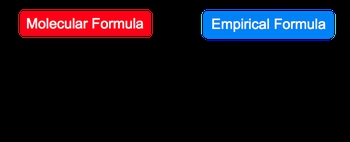In this video, we're going to take a look at the difference between our empirical formula and molecular formula. First of all, when it comes to the empirical formula of a compound, we're going to say it's related to the mass percentage of its constituent elements using the mole concept. Remember, the mole concept has to do with us going between grams, moles, and units such as molecules, ions, or atoms. We're going to say here that when it comes to our compound, the empirical formula gives us the relative number of atoms and represents the most simplified form. So by convention, we're going to say any formula must contain whole numbers of each atom in what's called the whole number ratio. Now let's put this to practice and really understand what's the difference between molecular formula and empirical formula. Here, we have the molecular formulas of different compounds. This is how many actual elements of each type that are present within that compound. The empirical formula can be thought of as its reduced or simplified form.
So if we take a look here, we have C3H6O3. Realize that here 3, 6, and 3 are all divisible by 3. So if I divide this by 3, what I'll have left is C1H2O. That C1H2O represents the reduced, simplified form or the empirical formula. If we look at the next one, we have C10H14N2. All these numbers here are divisible by 2. So when we divide everything by 2, we're going to get C5H7N. That represents the empirical formula.
And then finally we have C12H22O11. They don't share any number in common where we can reduce it to a simplified form, so we'd actually have the same empirical formula as molecular formula, and we'll see from time to time that is true. So just remember that your molecular formula is the actual number of each of the elements within a compound, and the empirical formula is the reduced form of that compound. Keep this in mind when doing a comparison of molecular formula versus empirical formula.


